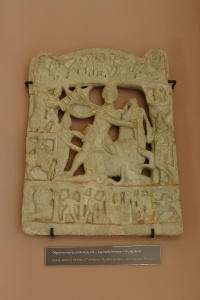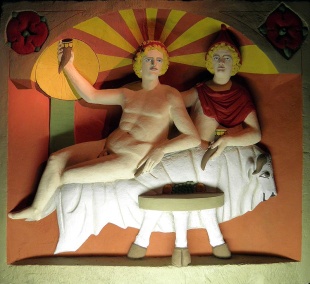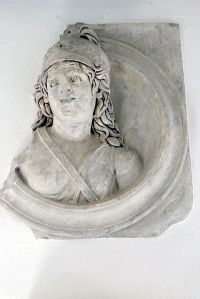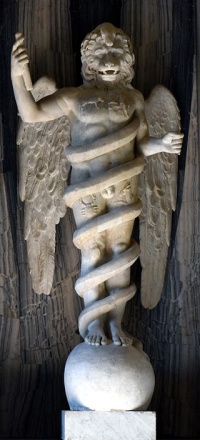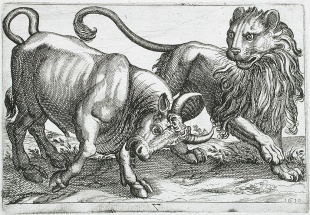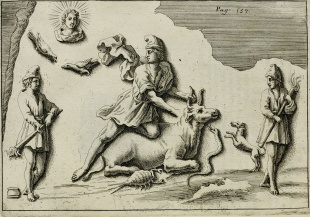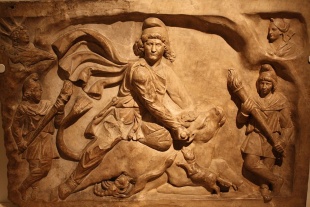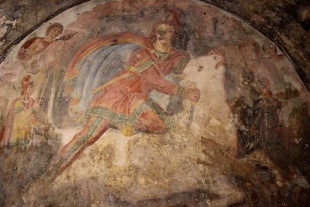MITHRAISM BELIEFS
Mithraism was a mystery cult that developed in the Roman empire. David Fingrut wrote: “The worshippers of Mithras held strong beliefs in a celestial heaven and an infernal hell. They believed that the benevolent powers of the god would sympathize with their suffering and grant them the final justice of immortality and eternal salvation in the world to come. They looked forward to a final day of judgement in which the dead would resurrect, and to a final conflict that would destroy the existing order of all things to bring about the triumph of light over darkness. [Source: David Fingrut in conjunction with a high-school course at Toronto's SEED Alternative School, 1993, based largely on the work of Franz Cumont (1868-1947) /]
“Purification through a ritualistic baptism was required of the faithful, who also took part in a ceremony in which they drank wine and ate bread to symbolize the body and blood of the god. Sundays were held sacred, and the birth of the god was celebrated annually on December the 25th. After the earthly mission of this god had been accomplished, he took part in a Last Supper with his companions before ascending to heaven, to forever protect the faithful from above. /
“The Babylonians also incorporated their belief in destiny into the Mithraic worship of Zurvan, the Persian god of infinite time and father of the gods Ahura-Mazda and Ahriman. They superimposed astrology, the use of the zodiac, and the deification of the four seasons onto the Persian rites of Mithraism. In Armenian tradition, Mithras was believed to shut himself up in a cave from which he emerged once a year, born anew.”
According to Encyclopedia of Religion: What promise Mithra held for his devotees cannot be known for certain. The cult seems to have encouraged soldierly qualities, including sexual abstinence. It certainly presented some correspondence between the degrees of initiation and the levels of the celestial spheres, which probably implies an ascent of the soul to these spheres. The killing of the bull (different from the taurobolium and perhaps without any implication of baptism) was apparently felt to be a sacrifice performed not for the god but by the god. The initiates reenacted this sacrifice and shared sacred meals in a sort of communal life. The progressive transformation of the soul of the initiate in this life, on which much of the cult focused, was probably conceived to continue after death. Tertullian considered Mithraism a devilish imitation of Christianity, but the Neoplatonist Porphyry found in it allegorical depths. [Source: Arnaldo Momigliano (1987), Simon Price (2005), Encyclopedia of Religion, Encyclopedia.com]
RELATED ARTICLES:
MITHRAISM: MITHRAS, PERSIA, CHRISTIANITY europe.factsanddetails.com ;
HISTORY OF MITHRAISM: ORIGIN AND SPREAD IN THE ROMAN EMPIRE europe.factsanddetails.com ;
CULTS IN THE GREEK AND ROMAN WORLD europe.factsanddetails.com ;
MAGNA MATER (CYBELE) CULTS: ATTIS, SELF-CASTRATED PRIESTS, BULL SACRIFICE europe.factsanddetails.com
Websites on Ancient Rome: Internet Ancient History Sourcebook: Rome sourcebooks.fordham.edu ; Internet Ancient History Sourcebook: Late Antiquity sourcebooks.fordham.edu ; BBC Ancient Rome bbc.co.uk/history; Perseus Project - Tufts University; perseus.tufts.edu ; Lacus Curtius penelope.uchicago.edu; The Internet Classics Archive classics.mit.edu ; Bryn Mawr Classical Review bmcr.brynmawr.edu; Cambridge Classics External Gateway to Humanities Resources web.archive.org; Ancient Rome resources for students from the Courtenay Middle School Library web.archive.org ; History of ancient Rome OpenCourseWare from the University of Notre Dame web.archive.org ; United Nations of Roma Victrix (UNRV) History unrv.com
RECOMMENDED BOOKS:
“The Origins of the Mithraic Mysteries: Cosmology and Salvation in the Ancient World” by David Ulansey (1991) Amazon.com;
“The Roman Cult of Mithras: The God and His Mysteries” by Manfred Clauss (2001) Amazon.com;
“The Religion of the Mithras Cult in the Roman Empire: Mysteries of the Unconquered” by Roger Beck Amazon.com;
“Images of Mithra” (Visual Conversations in Art and Archaeology Series)
by Philippa Adrych, Robert Bracey, Dominic Dalglish (2017) Amazon.com;
“Religion in the Roman Empire” by James B. Rives Amazon.com;
“Mystery Cults in the Ancient World” by Hugh Bowden (2023) Amazon.com;
“The Mystery-Religions” by S. Angus (2011) Amazon.com;
“The Secret Sacred: Mystery Cults in Ancient Greece and Rome” by Damien Stone (2025) Amazon.com;
“God Who Comes, Dionysian Mysteries Reclaimed: Ancient Rituals, Cultural Conflicts, and Their Impact on Modern Religious Practices” (2003) by Rosemarie Taylor-Perry Amazon.com;
“The Greco-Roman Cult of Isis” by Harold R. Willoughby (2017) Amazon.com;
“The Oxford Dictionary of Classical Myth and Religion” by Simon Price and Emily Kearns (2003) Amazon.com;
“Religions of Rome: Volume 1: A History” by Mary Beard, John North, Simon Price ( Amazon.com;
“Religions of Rome: Volume 2: A Sourcebook” by Mary Beard, John North, Simon Price ( Amazon.com;
“The Dancing Lares and the Serpent in the Garden: Religion at the Roman Street Corner” by Harriet I. Flower (2017) Amazon.com;
“Magic and Religion in the Ancient Mediterranean World” by Radcliffe G. Edmonds III and Carolina López-Ruiz (2023) Amazon.com
Mithraic Worship
According to the Metropolitan Museum of Art: “The religion of Mithras was practiced in small groups, with ten to twelve participants. Initiates into this secret cult immediately entered a priestly hierarchy, an order of seven grades, each with specific planets, costumes, rituals, and disciplines aimed at self-advancement. Members of the cult met in a mithraeum, an underground vaulted grotto with complex astronomical and planetary symbolism. The small space of the cavern, the cult practices, and the ritual meal were modeled on the original space and deeds of Mithras—the sacrifice of a bull and the eating of its flesh.” [Source: Claudia Moser, Metropolitan Museum of Art, April 2007, metmuseum.org \^/]
Kiki Karoglou of the Metropolitan Museum of Art wrote: A “sequence of levels of initiation, the so-called seven grades, was observed in Mithraism... Mithras was of Persian origin and was considered a redemption god, somewhat similar to Isis and Dionysos. No myths about Mithras survive and there were no public festivals in his honor. What is known about his worship derives mostly from archaeology. Mithraism was particularly popular with the Roman legions, and mithraea, the shrines where the mysteries took place, are found everywhere in the empire, but especially at sites along the northern frontier. These were rectangular buildings designed to resemble caves: they lay partly underground with barrel-vaulted ceilings and no windows. Torches and lamps provided light for the performance of indoor rituals that involved rather small groups. [Source: Kiki Karoglou, Department of Greek and Roman Art, Metropolitan Museum of Art, October 2013, metmuseum.org \^/]
Professor Roger Beck of the University of Toronto Mississauga wrote for the BBC: “We know of no Mithraic authority higher than the ‘Father’ presiding over his group of thirty or so brother initiates: no Mithraic bishops or pope, and no orthodoxy to define and squabble about. Typically, the Mithraic meeting place was a medium-sized room, furnished with solid platforms on the longer walls. On these 'side-benches' the initiates reclined for the cult meal, which was their principal ceremony. [Source: Professor Roger Beck, BBC, February 17, 2011 |::|] “This cult meal was both an actual feast and a ritual memorial, unlike the Christian eucharist which developed solely into a sacramental ritual. In the Eucharistic sacrament, Christians memorialise Christ’s self-sacrifice by partaking of Christ’s body and blood in the form of bread and wine. The Mithraists in their cult meal memorialised the feast which Mithras and the Sun shared as they reclined on the hide of the bull sacrificed by Mithras in the sacred story. One needs only add, because of rampant misinformation, that the actual killing of a bull played no part in Mithraic ritual. |::|
David Fingrut wrote: “The Mithraic clergy's duty was to maintain the perpetual holy fire on the altar, invoke the planet of the day, offer the sacrifices for the disciples, and preside at initiations. The Mithraic priests were known as Patres Sacrorum, or Fathers of the Sacred Mysteries. They were mystically designated with the titles Leo and Hierocorax, and presided over the priestly festivals of Leontica (the festival of lions), Coracica (the festival of ravens), and Hierocoracica (the festival of sacred ravens). [Source: David Fingrut in conjunction with a high-school course at Toronto's SEED Alternative School, 1993, based largely on the work of Franz Cumont (1868-1947) /]
“The great festival of the Mithraic calendar was held on December the 25th, and the 16th of every month was kept holy to Mithras. The first day of the week was dedicated to the sun, to whom prayers were recited in the morning, noon, and evening. Services were held on Sundays, in which bells were sounded and praises were offered to Mithras. On great occasions, the 'soldiers of Mithras' took part in the sacrament of bread and wine as sacred bulls were sacrificed.” /
Mithraic Rituals
David Fingrut wrote: “As 'God of Truth and Integrity', Mithras was invoked in solemn oaths to pledge the fulfillment of contracts and punish liars. He was believed to maintain peace, wisdom, honour, prosperity, and cause harmony to reign among all his worshippers. According to the Avesta, Mithras could decide when different periods of world history were completed. He would judge mortal souls at death and brandish his mace over hell three times each day so that demons would not inflict greater punishment on sinners than they deserved. [Source: David Fingrut in conjunction with a high-school course at Toronto's SEED Alternative School, 1993, based largely on the work of Franz Cumont (1868-1947) /]
“Sacrificial offerings of cattle and birds were made to Mithras, along with libations of Haoma, a hallucinogenic drink used by Zoroastrian and Hindu priests, equated with the infamous hallucinogen 'Soma' described in the Vedic scriptures. Before daring to approach the altar to make an offering to Mithras, Persian worshippers were obliged to purge themselves by repeating purification rituals and flagellating themselves. These customs were continued in the initiation ceremonies of the Roman neophytes. /
“Worshippers took part in masquerading as animals, such as ravens and lions, and inserted passages into their ritual chants that were devoid of any literal meaning. All of these rites that characterized Roman Mithraism originated in ancient prehistoric ceremonies. During the rituals, the evolution of the universe and the destiny of mankind was explained. The service consisted chiefly of contemplating the Mithraic symbolism, praying while knelt before benches, and chanting hymns to the accompaniment of flutes. Hymns were sung describing the voyage of Mithras' horse-drawn chariot across the sky. Invokers and worshippers of Mithras prayed, "Abide with me in my soul. Leave me not [so] that I may be initiated and that the Holy Spirit may breathe within me." Animal sacrifices, mostly of birds, were also conducted in the Mithraeums.” /
Kiki Karoglou of the Metropolitan Museum of Art wrote: A ““In all mithraea, a central cult image was displayed at the end opposite the entrance. It represented a ritual bull-killing, a tauroctony: the god Mithras, wearing a cloak and a "Phrygian" cap, kneels on the back of a bull pulling back its head and stabbing it in the neck with a sword. A scorpion attacks the bull's testicles, while a dog and a snake are stretching up to drink the blood dripping from the wound. A raven flies above, and personifications of the sun to the right and the moon to the left complete the scene. All elements of the tauroctony correspond to constellations of the night sky. The mithraeum is often viewed as an astrological representation of the universe with Mithras as the Sun god himself, with whom he was eventually assimilated: "Deus Sol Invictus Mithras" (the Unconquered Sun God Mithras).” [Source: Kiki Karoglou, Department of Greek and Roman Art, Metropolitan Museum of Art, October 2013, metmuseum.org \^/]
Dr Nigel Pollard of Swansea University wrote for the BBC: ““A sculpted relief from Rome depicts the central image of Mithraism - Mithras slaying a bull. This is accompanied by a number of figures that probably relate to Mithraic ritual and theology, including the torch-bearers on each side. A figure in the top left corner with a radiate crown represents the sun, and alludes to the relationship of Mithras with the cult of the Unconquered Sun. [Source: Dr Nigel Pollard of Swansea University, BBC, March 29, 2011 |::|]
Mithraic Mystery Cult
David Fingrut wrote: “Mithraism was an archetypal mystery cult and secret society. Like the rites of Demeter, Orpheus, and Dionysus, the Mithraic rituals admitted candidates by secret ceremonies, the meaning of which was known only to the initiated. Like all other institutionalized initiation rites of the past and present, this mystery cult allowed the initiates to be controlled and put under the command of their leaders. Preceding initiation into the Mithraic fold, the neophyte had to prove his courage and devotion by swimming across a rough river, descending a sharp cliff, or jumping through flames with his hands bound and eyes blindfolded. The initiate was also taught the secret Mithraic password, which he was to use to identify himself to other members, and which he was to repeat to himself frequently as a personal mantra. [Source: David Fingrut in conjunction with a high-school course at Toronto's SEED Alternative School, 1993, based largely on the work of Franz Cumont (1868-1947) /]
“Mithraic worshippers believed that the human soul descended into the world at birth. The goal of their religious quest was to achieve the soul's ascent out of the world again by gaining passage through seven heavenly gates, corresponding to seven grades of initiation. Therefore, being promoted to a higher rank in the religion was believed to correspond to a heavenly journey of the soul. Promotion was obtained through submission to religious authority (kneeling), casting off the old life (nakedness), and liberation from bondage through the mysteries. /
“However, the worshippers of Mithras did not lose themselves in a contemplative mysticism like the followers of other near-eastern sects. Their morality particularly encouraged action, and during a period of war and confusion, they found stimulation, comfort and support in its tenets. In their eyes of the Roman soldiers, resistance to evil deeds and immoral actions became just as valued as victory in glorious military exploits. They would fight the powers of evil in accordance with the ideals of Zoroastrian dualism, in which life was conceived as a struggle against evil spirits. /
“By supplying a new conception of the world, Mithraism gave new meaning to life by determining the worshipper's beliefs concerning life after death. The struggle between good and evil was extended into the afterworld, where Mithras ensured the protection of his followers from the powers of darkness. It was believed that Mithras would judge the souls of the dead and lead the righteous into the heavenly regions where Ahura-Mazda reigned in eternal light. Mithraism brought the assurance that reverence would be rewarded with immortality.” /
Mithraic Initiation
Debra Kelly wrote for Listverse: “While we’re not entirely sure what an initiation ceremony into the cult looked like, we have some tantalizing clues. A manuscript from Florence tells us that the ceremony was performed by two men called the Father and the Herald. The initiate would recite an oath promising his secrecy and at the end he would have his hands branded or tattooed (although some portraits show the tattoos on a person’s forehead). [Source: Debra Kelly. Listverse, April 30, 2016 ]
“There were then a series of trials, which we know about from murals on the walls of a grotto in Capua. One image shows a naked and blindfolded initiate being guided by a white-robed figure. The next shows the same blindfolded initiate kneeling while someone approaches him from behind, armed with what looks like either a sword or a stick. The third shows the initiate on one knee, a sword on the ground next to him, with one of the men standing behind him with his hands on his head. Other images show other parts of the ceremony and depict the initiate lying on the ground, being pushed over by one man while another walks toward them, and kneeling while holding his hands under his chin. A fourth-century text says the sword is used to cut the chicken-gut bindings that ties the initiate’s hands. By this time, the records get increasingly fantastic with claims that initiates went through greater and greater challenges like spending days submerged in water and more.”
David Fingrut wrote: “The Mithras worshippers compared the practice of their religion to their military service. All of the initiates considered themselves sons of the same father owing to one another a brother's affection.... The process of Mithraic initiation required the symbolic climbing of a ceremonial ladder with seven rungs, each made of a different metal to symbolize the seven known celestial bodies. By symbolically ascending this ceremonial ladder through successive initiations, the neophyte could proceed through the seven levels of heaven. The seven grades of Mithraism, were: Corax (Raven), Nymphus (Male Bride), Miles (Soldier), Leo (Lion), Peres (Persian), Heliodromus (Sun-Runner), and Pater (Father); each respective grade protected by Mercury, Venus, Mars, Jupiter, the Moon, the Sun, and Saturn. [Source: David Fingrut in conjunction with a high-school course at Toronto's SEED Alternative School, 1993, based largely on the work of Franz Cumont (1868-1947) /]
“The lowest degree of initiation into the grade of Corax symbolized the death of a new member, from which he would arise reborn as a new man. This represented the end of his life as an unbeliever, and cancelled previous allegiances to the other unacceptable beliefs. The title Corax (Raven) originated with the Zoroastrian custom of exposing the dead on funeral towers to be eaten by carrion birds, a custom continued today by the Parsis of India, the descendants of the Persian followers of Zarathustra. /
“Further initiation involved the clashing of cymbals, beating of drums, and the unveiling of a statue of Mithras. The initiate drank wine from the cymbal to recognize it as the source of ritual ecstasy. Next, he ate a small morsel of bread placed on a drum, to signify his acceptance of Mithras as the source of his food. This bread had been exposed to the rays of the sun, so by eating the bread the worshipper was partaking of the divine essence of the sun itself. The initiate would also offer a loaf of bread and cup of water to the statue of Mithras. /
“When a neophyte reached the degree of Miles (soldier), he was offered a crown, which he had to reject with the saying "Only Mithras is my crown". The indelible mark of a cross, symbol of the sun, was then branded on his forehead with a hot iron to symbolize his ownership by the deity, and he would renounce the social custom of wearing a wreath. From then on, the neophyte belonged to the sacred militia of 'The Invincible God Mithras'. All family ties were severed and only fellow initiates were to be considered brothers.” /
Mithraic Initiation Grades
Debra Kelly wrote for Listverse: “Initiates into the cult of Mithras had the potential to rise through a series of different grades. We know that there were seven different levels, and most of what we’ve managed to uncover about them has only come to light in the past century. But we still don’t know a lot, including what an initiate might have actually been called. [Source: Debra Kelly. Listverse, April 30, 2016 ]
“Uncovering their roles took some work. Some of our primary sources are temple mosaics, like the one on the floor of the Mithraeum of Felicissimus in Ostia, and graffiti that was left on other temple walls. Comparing images has helped put together something of a list.
“The Raven, or Corax, was associated with the cup, the staff of Mercury, and the planet Mercury. The Bridegroom, or Nymphus, seems to be associated with the oil lamp, a diadem, and a third symbol that no one’s been able to decode yet. It has some kind of connection with the planet Venus, and it’s one of the most debated in part because it refers to a creature that doesn’t actually exist—a male bride—and virtually nothing about the role they served has been uncovered. The third grade is the Soldier, or Miles, and it’s been associated with the helmet and lance, along with the planet Mars.
“The Fourth is the Lion, Leo, symbolized by thunderbolts, rattles, and fire-shovel in mosaic depictions (above). Somehow connected with the planet Jupiter, we have a few texts that talk about the lions as moral guardians and how they were purified by honey. The Persian, or Perses, is another we know nothing about aside from its symbolic associations: the Moon, the Persian dagger, the moon sickle, the plow, and the star.
“The Runner of the Sun is also called Heliodromus, and they were under the protection of the Sun. It’s suggested that there was some connection to a bird that was said to follow the path of the Sun in the sky, and these were associated with the whip, the torch, and a crown with seven rays. Because of their connection to the Sun, it’s thought they were responsible for some sort of yearly ceremony relating to the Sun’s path.
“The final grade is the Father, or Pater, who oversaw the rest of the community. They shared some symbols with Mithras himself, like the Phrygian cap, the staff, the dagger, and the sacrificial bowl, and were likely responsible for guiding others through the process. There are more questions than answers about the seven grades. Were they arranged in a hierarchy, or were the roles independent from each other? Were they universal throughout the wide spread of the cult? We’re not really sure.”
Mithraeums: Underground Mithraic Temples
More than 200 temples dedicated to the worship of Mithras have been found in what was formally the Roman Empire, from Britain to Syria, along the Rhine and into Italy. They have been found buried under Christian churches and ensconced in natural caves. The imagery found inside is relatively uniform across this huge territory. [Source: Debra Kelly. Listverse, April 30, 2016]

from inside a Mithraeum
David Fingrut wrote: “Worshippers used caves and grottos as temples wherever possible, or at least gave temples the internal appearance of caves or of being subterranean by building steps leading down to the entrance. The Persians introduced initiates to the mysteries in natural caves, according to Porphyry, the third century neoplatonic philosopher. These cave temples were created in the image of the World Cave that Mithras had created, according to the Persian creation myth. [Source: David Fingrut in conjunction with a high-school course at Toronto's SEED Alternative School, 1993, based largely on the work of Franz Cumont (1868-1947) /]
David Ulansey wrote in “The Cosmic Mysteries of Mithras”: “The typical mithraeum was a small rectangular subterranean chamber, on the order of 75 feet by 30 feet with a vaulted ceiling. An aisle usually ran lengthwise down the center of the temple, with a stone bench on either side two or three feet high on which the cult's members would recline during their meetings. On average a mithraeum could hold perhaps twenty to thirty people at a time. [Source: David Ulansey: “The Cosmic Mysteries of Mithras”, (Oxford University Press, 1991), Well.com ++]
“At the back of the mithraeum at the end of the aisle was always found a representation — usually a carved relief but sometimes a statue or painting — of the central icon of Mithraism: the so-called tauroctony or "bull-slaying scene" in which the god of the cult, Mithras, accompanied by a dog, a snake, a raven, and a scorpion, is shown in the act of killing a bull. Other parts of the temple were decorated with various scenes and figures. There were many hundreds — perhaps thousands — of Mithraic temples in the Roman empire. The greatest concentrations have been found in the city of Rome itself, and in those places in the empire (often in the most distant frontiers) where Roman soldiers — who made up a major segment of the cult's membership — were stationed.” ++
Fingrut wrote: “The largest near-eastern Mithraeum was built in western Persia at Kangavar, dedicated to 'Anahita, the Immaculate Virgin Mother of the Lord Mithras'.1 Other Mithraic temples were built in Khuzestan and in Central Iran near present-day Mahallat, where at the temple of Khorheh a few tall columns still stand. Excavations in Nisa, later renamed Mithradatkirt, have uncovered Mithraic mausoleums and shrines. Mithraic sanctuaries and mausoleums were built in the city of Hatra in upper Mesopotamia. West of Hatra at Dura Europos, Mithraeums were found with figures of Mithras on horseback. /
Debra Kelly wrote for Listverse: “Examinations of the temple under what’s now a church in Rome sparked the suggestion that a brick platform and a series of niches served as a sort of lecture hall where future initiates would be told all they needed to know about the mysteries they were swearing themselves to—but others say it was probably just a meeting room of some sort.” [Source: Debra Kelly. Listverse, April 30, 2016 ]
Elephant’s Tomb
Debra Kelly wrote for Listverse: “The Elephant’s Tomb is the modern name given to an ancient structure in a Roman necropolis in Seville, Spain, and the name came from a statue that was discovered in one of the interior rooms. More excavations done in the rooms suggest it wasn’t always a burial ground; it originally may have been a temple to Mithras. [Source: Debra Kelly. Listverse, April 30, 2016 ] “Archaeological evidence shows that the structure as it stands now went through four distinct phases. A window was part of the first stage, and researchers from the University of Pablo de Olavide in Seville found that it had a symbolic purpose. During the spring and autumn equinoxes, the light streaming into the central chamber would have shown directly on the center of the room. During the two solstices, the light would have lit the north and south walls. It’s also aligned with two of the constellations that were most important to the Mithraic order: Scorpio and Taurus. The image of Mithras killing a bull is the most commonly seen cult image, and it also shows the scorpion stinging the bull (above) as Mithras kills it.
“They now believe that a statue of Mithras in his famous bull-slaying pose would have sat in the center of the room to be illuminated by the Sun’s rays on astronomically important days. The first life of the tomb was hidden during three subsequent renovations, but there are, of course, still objections to the idea. Whether the three-chambered room was used for the mysterious rites and rituals of Mithras has yet to be proven, but it also raises the question of how many more temples and caves are out there that we have yet to find.”
Taurobolium: Bull Blood Ritual
David Fingrut wrote: “While Mithras was worshipped almost exclusively by men, most of the wives and daughters of the Mithraists took part in the worship of Magna Mater, Ma-Bellona, Anahita, Cybele, and Artemis. These goddess religions practiced a regeneration ritual known as the Taurobolium, or bull sacrifice, in which the blood of the slaughtered animal was allowed to fall down upon the initiate, who would be lying, completely drenched in a pit below. As a result of their association with practitioners of this rite, Mithraists soon adopted the Taurobolium ritual as their own. [Source: David Fingrut in conjunction with a high-school course at Toronto's SEED Alternative School, 1993, based largely on the work of Franz Cumont (1868-1947) /]
“This baptism of blood became a renewal of the human soul, as opposed to mere physical strength. Mithraic baptism wiped out moral faults; the purity aimed at had become spiritual. The descent into the pit was regarded as symbolic burial, from which the initiate would emerge reborn, purified of all his crimes and regarded as the equal of a god. Those who made it through the Taurobolium were revered by their brethren, and accepted in the fold of Mithraism.” /
Franz Cumont wrote in “The Oriental Religions in Roman Paganism: "The taurobolium had become a means of obtaining a new and eternal life; the ritualistic ablutions were no longer external and material acts, but were supposed to cleanse the soul of its impurities and to restore its original innocence; the sacred repasts imparted an intimate virtue to the soul and furnished sustenance to the spiritual life." [Source: Cumont, Franz. “The Oriental Religions in Roman Paganism,” Dover Publications, Inc. New York, 1956].
Bull Symbol
David Fingrut wrote: “The bull has been exalted throughout the ancient world for its strength and vigour. Greek myths told of the Minotaur, a half-man half-bull monster who lived in the Labyrinth beneath Crete, and took an annual sacrifice of six young men and six maidens before being slain by the hero Theseus. Minoan artwork depicted nimble acrobats leaping bravely over the backs of bulls. The altar in front of Solomon's Temple in Jerusalem was adorned with bull horns believed to be endowed with magical powers. The bull was also one of the four tetramorphs, the symbols later associated with the four gospels. The mystique of this powerful animal still survives today in the ritualistic bull-fighting of Spain and Mexico, and in the rodeo bull-riding of the U.S. [Source: David Fingrut in conjunction with a high-school course at Toronto's SEED Alternative School, 1993, based largely on the work of Franz Cumont (1868-1947) /]
“The bull was an obvious representation of masculinity by nature of its size, strength, and sexual power. At the same time, the bull symbolized lunar forces by virtue of its horns and earthly forces by virtue of its powerful root to the ground. The ritual sacrifice of the bull symbolized the penetration of the feminine principle by the masculine. The slaying of the bull represented the victory of man's spiritual nature over his animality; parallel to the symbolic images of Marduk slaying Tiamut, Gilgamesh killing Humbaba, Michael subduing Satan, St. George slaying the dragon, the Centurion piercing Christ's side, Lewis Carroll's "beamish boy" slaying the Jabberwocky, and Sigourney Weaver slaying the Alien.” /
Bull and Roman Mithraic Legends
David Fingrut wrote: “According to the archetypal hero myth recited in Roman Mithraic rituals, the infant Mithras formed an alliance with the sun and set off to kill the bull, the first living creature ever created. While the bull was grazing in a pasture, Mithras seized it by the horns and dragged it into a cave. The bull soon escaped, but was recaptured when Mithras was given the command by the raven, messenger of the sun, to slay the bull. With the help of his dog, Mithras succeeded in overtaking the bull and dragging it again in the cave. Then, seizing it by the nostrils, he plunged deep into its flank with his knife. [Source: David Fingrut in conjunction with a high-school course at Toronto's SEED Alternative School, 1993, based largely on the work of Franz Cumont (1868-1947) /]
“As the bull died, the world came into being and time was born. From the body of the slain beast sprang forth all the herbs and plants that cover the earth. From the spinal cord of the animal sprang wheat to produce bread, and from the blood came the vine to produce wine. The shedding of the sacrificial blood brought great blessings to the world, which Ahriman tried to prevent. The struggle between good and evil which at that moment first began was to continue until the end of time.” /
Franz Cumont wrote in “The Oriental Religions in Roman Paganism: "This ingenious fable carries us back to the very beginnings of civilization. It could never have risen save among a people of shepherds and hunters with whom cattle, the source of all wealth, had become an object of religious veneration." [Source: Cumont, Franz. “The Oriental Religions in Roman Paganism,” Dover Publications, Inc. New York, 1956].
Mithraic Taurobolium Ritual
David Fingrut wrote: “Mithraic sculpture depicted the Taurobolium with invariable consistency. Mithras was always depicted in the cave kneeling on the back of the bull, dagger in hand, wearing a flowing cape and Phrygian cap. He was shown pulling back the bull's head by its nostrils and stabbing it with the dagger, back foot extended over the bull's right leg. A dog and a snake were shown leaping into bull's wound, representing the dualistic conflict of good and evil at the moment of creation. A scorpion was shown at the bull's genitals, depicting evil seeking to destroy life at its source. Ears of corn sprung from the tail of the bull representing victory of good over evil. [Source: David Fingrut in conjunction with a high-school course at Toronto's SEED Alternative School, 1993, based largely on the work of Franz Cumont (1868-1947) /]
“During the celebration of the vernal equinox, the Phrygian priests of the Great Mother attributed the blood shed in the Taurobolium to the redemptive power of the blood of the Divine Lamb shed on the Christian Easter. It was maintained that the dramatic Taurobolium purification ritual was more effective than baptism. The food that was taken during the mystic feasts was likened to the bread and wine of the communion; the Mother of the Gods (Magna Mater) received greater worship than the Mother of God (Mary), whose son also had risen again. /
“An inscription in the Mithraeum under the Church of Santa Prisca in Rome referred to Mithras saving men by shedding the eternal blood of the bull. On the very spot on which the last Taurobolium took place at the end of the fourth century, in the Phrygianum, today stands the Vatican's St. Peter's Basilica.” /
Mithraism and the Stars
Debra Kelly wrote for Listverse: “The image of Mithras killing the bull—the tauroctony—is the most widely found image associated with the religion. It’s always oddly specific, too, with Mithras in the same position, with the same elements of the bull itself and the scorpion, and in reliefs, he’s always accompanied by two other figures called Cautes and Cautopates. A lion and a bowl are sometimes featured as well, and most of the intact reliefs are framed by an arch. For all the examples of the image we’ve found, no one has ever found a single text from anywhere near the era of Mithras telling how the image was supposed to be interpreted or why it’s so specific. [Source: Debra Kelly. Listverse, April 30, 2016 ]
“According to the writings of the Roman philosopher Porphyry, Mithras was symbolic of the figure of Mars and was tied to the constellation of Aries. The bull was, of course, Taurus, and associated with the planet Venus. The scorpion, the lion and the twins are constellations as well, and it’s now thought that the imagery of the cult was depicting exactly what they were seeing in the night sky. Scorpio is always stinging the bull, who’s always standing with a bent foreleg featured in the constellation. The snake is in the same position as Hydra, and even the occasional inclusion of the lion can be explained by the idea that only constellations that overlapped the equatorial line were important enough to be included in the imagery. Sometimes, Leo was on the line, and sometimes it wasn’t, depending on the perspective of the viewer.
“This seems logical enough, but we’re still not sure exactly who Mithras was. Orion might seem the first choice, but the positioning is wrong. If the image is a map of the night sky, Mithras should be beneath the bull, not above it—and, the traditional weapon is wrong. There’s another figure in the night sky who’s also dressed in a Phrygian cap and who’s in the right position to be Mithras: Perseus. If Perseus was the inspiration for Mithras, it also explains one of the strangest elements of the Mithras relief. As he delivers the killing blow, Mithras is looking away from the bull, which matches how Perseus is positioned in the night sky.”
Mithra and the Gemini Twins
In one famous image, Mithras is shown standing between twins Gemini twins — Cautes and Cautopates. Debra Kelly wrote for Listverse: “Some inscriptions on the reliefs mention them by name, so we know what those names are and which is which: Cautes holds his torch upright, while Cautopates holds his upside down. In some examples, Cautes is shown holding the head of a bull and Cautopates is given a scorpion, further cementing the idea that they’re related to the constellations by linking the imagery to the entrance of the Sun into the zodiac during the spring and fall equinoxes. [Source: Debra Kelly. Listverse, April 30, 2016 ]
“What we don’t know is there they came from, what their names mean, or where the names originated. There’s no mention of them in the original Persian and Zoroastrian mythology, and even though their names sound like they should be Iranian, they aren’t. Tracing the origins of the names means a lot of wading through waist-deep linguistic mud, but by the time you get through ancient Greek, Turkish, and Iranian, the closest thing you can possibly find as the basis for the names are words that we translate as “Heap” and “Collapse of a Heap.”
“So that’s unlikely. We’re not sure what they’re supposed to represent, either. One interpretation is that Cautes represents the dawn, Mithras (always between the two) is the midday sun, and Cautopates is the sunset. It’s also been suggested that Cautes is birth, Mithras is life, and Cautopates is death.It’s made even more complicated that sometimes both figures are holding their torches upright. No one knows if they’re both supposed to be Cautes or if there’s some sort of other meaning to these images that we’ve likely lost forever.”
Lion-Headed Statues
Debra Kelly wrote for Listverse: “While the cult obviously centers on the figure of Mithras, there’s another figure that’s central to the cult ideas—and no one knows who he is. The figures have been found in the form of idols and as statues, and while there are some differences in their presentation, they’re basically the same. The figure has the head of a lion, wings draped across the back and sometimes folded around the front, with a snake wrapped around it from ankles to chest. The figure sometimes holds a sword, a staff, a key, or a torch, and sometimes the now-familiar figures of the zodiac are included. The mouth of the lion is always open, and some figures have a hole carved inside the mouth. [Source: Debra Kelly. Listverse, April 30, 2016 ]
“No one’s sure who it’s supposed to be or what it represents. Some think it’s the Zoroastrian god of time, called Zurvan. Zurvan was an eternal figure who stood in direct opposition to Ahriman, the Evil Spirit. Others think it’s supposed to be the Evil Spirit himself. Some inscriptions refer to the burning of incense inside the statue to create the image of a fire-breathing beast, and the image of the lion itself seems to suggest a demonic nature, at least according to the Zoroastrian traditions. And snakes have a long history of being depicted as evil, but the answer might also lie in the writings of another mystery cult. The Yazidi mystery cult of Iraq and Armenia uses snakes as their Destructive-Creators, and a manuscript from the Iranian province of Luristan tells the story of an evil creature whose name translates to “Lionish-God.”
“The lion-headed figure is thought to represent everything beyond the zodiac that features so heavily in Mithraic teachings. He might be a gatekeeper, he might be an evil creature holding the keys to knowledge or heaven, or he might have something to do with the binding and releasing of souls.”

statues retrieved from a Mithraeum
Image Sources: Wikimedia Commons
Text Sources: Internet Ancient History Sourcebook: Rome sourcebooks.fordham.edu ; Internet Ancient History Sourcebook: Late Antiquity sourcebooks.fordham.edu ; “Outlines of Roman History” by William C. Morey, Ph.D., D.C.L. New York, American Book Company (1901) ; “The Private Life of the Romans” by Harold Whetstone Johnston, Revised by Mary Johnston, Scott, Foresman and Company (1903, 1932); BBC Ancient Rome bbc.co.uk/history/ ; Project Gutenberg gutenberg.org ; Metropolitan Museum of Art, National Geographic, Smithsonian magazine, New York Times, Washington Post, Los Angeles Times, Live Science, Discover magazine, Archaeology magazine, Reuters, Associated Press, The Guardian, AFP, The New Yorker, Wikipedia, Encyclopædia Britannica, Encyclopedia.com and various other books, websites and publications.
Last updated October 2024

